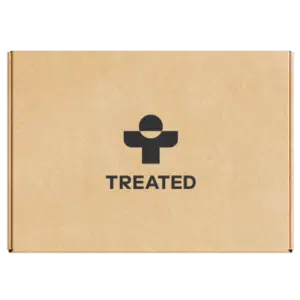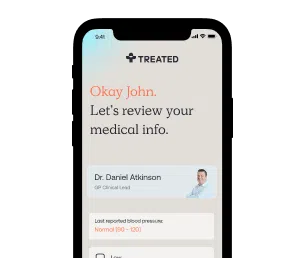Cream that soothes and treats seborrheic dermatitis.



Clotrimazole is an antifungal cream you can apply straight to your skin. It treats the symptoms of seborrhoeic dermatitis and can help prevent future flare-ups.
If you’re suffering from a red, flaky and itchy rash on your skin, we can help. Order Clotrimazole online with us and we’ll deliver it right to you.
Clotrimazole is a cream that’s often used for fungal infections, but it’s also an effective treatment for seborrhoeic dermatitis. You apply it straight to your scalp, face or upper trunk where you have red and flaky patches of skin.
Clotrimazole soothes flare-ups of seborrhoeic dermatitis as well as treating the underlying cause. So using it during flare-ups can help prevent you from having more in the future.
Clotrimazole is a type of antifungal called an azole, so it’s good at killing off fungus cells on the skin. It works by damaging the outer membranes of the fungus cells and stopping them from producing ergosterol, a substance that keeps them alive.
Clotrimazole works for seborrhoeic dermatitis by attacking the Malassezia species of yeast, which are a type of fungus. Seborrhoeic dermatitis is caused by your immune system reacting to an overgrowth of Malassezia yeast. This causes the sebum glands in your skin to become inflamed and leads to the flaking, redness and itching of seborrhoeic dermatitis. Clotrimazole brings down the inflammation by destroying the Malassezia yeast.
Clotrimazole cream comes as a cream containing 1% of the active ingredient clotrimazole. Your clinician will tell you exactly how much Clotrimazole to use based on your symptoms. You’ll usually need to use it twice or thrice a day for at least two weeks, whenever you have a flare-up of seborrhoeic dermatitis.

How we source info.
When we present you with stats, data, opinion or a consensus, we’ll tell you where this came from. And we’ll only present data as clinically reliable if it’s come from a reputable source, such as a state or government-funded health body, a peer-reviewed medical journal, or a recognised analytics or data body. Read more in our editorial policy.
Always use Clotrimazole as your clinician tells you. If you have any questions, go back and ask them. You can also message us if you ordered Clotrimazole from Treated.
The itching and irritation on your skin should be improved within a few days of starting Clotrimazole treatment. Redness and scaly or flaky patches may take longer to disappear. Always use Clotrimazole for as long as directed by your clinician, so its full effects can take hold.
If your symptoms haven’t improved within a few weeks, go back to your clinician or message us if you’re using our service. There are a range of effective treatments for seborrhoeic dermatitis you can try.
If you accidentally get Clotrimazole cream in your eyes, wash it out with clean water. Contact your clinician if you experience any symptoms like blurred vision or soreness. Covering your eyes with a towel while applying Clotrimazole may help you avoid this. If you accidentally swallow some, rinse out your mouth and seek medical attention right away.
If you forget to use Clotrimazole, just use it as soon as possible. If it’s nearly time for your next application, just skip that dose and wait for the next one. Don’t use extra Clotrimazole to make up for missing some. Don’t stop taking Clotrimazole just because it’s working, use the full course your clinician prescribed. Stopping treatment too early may cause your symptoms to come back.

How we source info.
When we present you with stats, data, opinion or a consensus, we’ll tell you where this came from. And we’ll only present data as clinically reliable if it’s come from a reputable source, such as a state or government-funded health body, a peer-reviewed medical journal, or a recognised analytics or data body. Read more in our editorial policy.
Have something specific you want to know? Search our info below, or ask our experts a question if you can’t find what you’re looking for.
Clotrimazole, 2021. StatPearls, Treasure Island
Seborrheic Dermatitis and Malassezia species: How Are They Related?. The Journal of clinical and aesthetic dermatology, 2(11), 14–17.
Topical Antifungals used for Treatment of Seborrheic Dermatitis. Journal of Bacteriology & Mycology: Open Access, 4(1).
Topical antifungals for seborrhoeic dermatitis. Cochrane Database of Systematic Reviews.

Registered with GMC (No. 4624794)
Meet Daniel
Registered with GPhC (No. 2202465)
Meet Sanjeda
Registered with GPhC (No. 2070724)
Meet Craig We know health, but you know you.
Our experts tell you what’s safe, but you decide what’s best.
Answer a few questions and tell us about yourself. Get tailored advice from our clinicians so you can choose better.

Choose your treatment and how often you have it delivered.

We know things change. It’s the nature of life. We’ll check in regularly to make sure your treatment is still right for you.
Pause. Change. Skip. Start again. Any time you like.
Always arrives on time and I’m kept informed of progress.
I have had it previously from my G.P so It worked as expected, extremely well. My problem is an accessing my G.P practice, they put ED well down their list of priorities. I found your service excellent, quick and efficient. I fully intend to continue using it
Shipping is speedy and the product is amazing.
Fast, slick service. Very easy to amend subscription when required.
Trusted service and great service - next day delivery and I can rely on them to send regularly.
Ordering was straight forward, tablets delivered promptly and well packaged, and instructions were clear, thanks.
Excellent delivery. Can’t fault.
Quick and efficient service, delivered discreetly the next day. Thank you.
Effective
Great service, no wait time
Great
Quick assessing for medicine suitability. Quick delivery and good communication throughout.
Straightforward and quick service!
Good however communication could sometimes be better
Easy and good procedure to get treatment
Excellent product
Excellent service!!! Ordered what I needed sent a picture of my prescription and the parcel arrived the next day!!! Will definitely order again and have recommended to others!!!
Fast shipping
Very quick service all round
So quick and simple. Recommend
Great
Very convenient hassle free service.
Easy to use good communication and fast shipping
Great service
Efficient no issues re delivery
Fabulous service
Brilliant service. Not a bad word to say!
It was fast, professional and it's the right med for what I selected in there.
This review requires content. Oh well..
Great service, quite effortless.
Top notch
Brill service
N/a
Excellent service quick and easy to use
Fast and exact order
Superb service and quick delivery 10/10
Excellent service
Thank you for fast delivery
Shipping is extremely quick and satisfiying
Good stuff
Good service
Great fast delivery
We're making healthcare more about you. Sign up to our newsletter for personalised health articles that make a difference.
Disclaimer: The information provided on this page is not a substitute for professional medical advice, diagnosis, or treatment. If you have any questions or concerns about your health, please talk to a doctor.
We couldn't find what you're looking for.
Here's everything we treat. Or, if you're looking for something we don't have yet, you can suggest something.
If there’s a particular treatment or condition you’re looking for, tell us and we’ll look into it for you.
Submit your question here, or tell us if you’ve found an issue on our site.
We’ll get back to you very soon. We aim to respond to all queries in one working day.
You’re signed up to our newsletter. Keep an eye on your inbox for our latest update.
By clicking 'Subscribe now' you're agreeing to our Privacy Policy.
We’ve sent you an email asking you to confirm your email address.